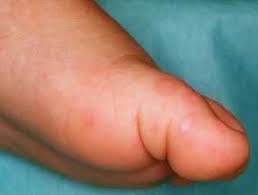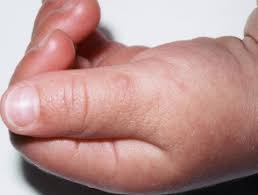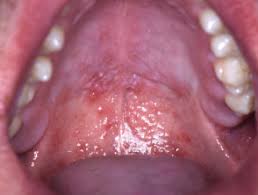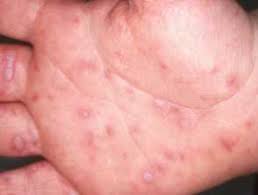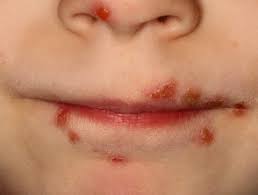Hand, foot and mouth disease (HFMD) is a common viral illness that typically occurs during the fall and summer but can manifest at any time. This highly contagious disease is prevalent in childcare and kindergartens, making it crucial for parents to be informed. In this guide, we will address common questions and concerns surrounding HFMD.
How does HFMD start? And what does it look like?
The initial symptoms, including fever, sore throat, and reduced appetite, usually surface 3-10 days after infection. Small red spots appear in the mouth, particularly on the tongue and gum. Additional red spots may become visible on the palms of the hands, soles of the feet, and other areas like the buttocks, genitals, knees, or elbows.
© DermaNetNZ
Is HFMD contagious (can it spread to adults)?
Yes, HFMD is highly contagious and can affect individuals of any age, with children under 10 years old being particularly susceptible. Good hygiene practices, such as regular handwashing, are essential to minimize the risk of transmission.

HFMD treatment and home remedies
There is no specific treatment for HFMD. As it is a viral infection, antibioitics won't work.
Symptoms can be managed by:
Keep your child home until all blisters have dried.
Ibuprofen to reduce pain and fever.
Cold, bland, and non-acidic foods like ice pops (avoid acidic foods) and drinks like water or milk (avoid juice) are recommended to soothe the mouth.
Good hygiene practices.
Children who are old enough can try gargling with saltwater to reduce sore throat pain.
YOUR MAIN GOALS ARE:
Keeping your child hydrated and comfortable.
Encourage handwashing.
Keep your child away from situations where they could infect others.
Here is a recommendation for itchy, weeping, inflamed skin:
As a wound manager, I have had highly positive experiences with Tannolact* over the past 15 years. This product is particularly effective for managing acute skin conditions characterized by inflammation, weeping, and itching. I personally recommend the bath additive, which is safe for use even on children. For personalized advice and to find the most suitable option for your child, I encourage you to consult with your pharmacist. They will guide you towards the right choice.
HFMD - When should we see a doctor?
Young children are at higher risk of serious infection than older children, teenagers, and adults. See your docotor when your child:
Isn’t drinking enough liquids to prevent dehydration.
Has a fever that lasts for more than three days.
Doesn’t seem to be improving after 10 days.
Has severe itching or blistering.
Has a weakened immune system.
Contact your pediatrician, describe the symptoms and inform them of your assumption. The medical practice needs this information to schedule you separately from other patients, possibly directing you to an isolation room or infection consultation.
Diagnosing HFMS happens by observing the skin. While there is no specific medicine for HFMD, a prescription for medication to reduce fever and pain can be provided.
If it's not the first occurrence, managing it at home may be an option. For a child sick note, contact your pediatrician.
ADDITIONAL COMMON QUESTIONS
Is HFMD itchy or painful?
While the skin rash associated with HFMD is generally not itchy, the disease can cause painful blisters, especially in the mouth and throat, making eating and drinking uncomfortable.

What causes hand, foot and mouth disease?
HFMD is caused by the coxsackie virus, a highly contagious virus that spreads through bodily fluids and respiratory droplets.
Is HFMD dangerous?
In the majority of cases, HFMD is a mild illness that resolves on its own within a week or so. Serious complications are rare, but vigilance, especially in young children, is important. What are the complications of this condition?
Occasionally, these problems occur:
Dehydration: Mouth sores can make drinking and eating painful. It’s important to drink enough fluids to prevent dehydration.
Nail loss: Some people lose a few fingernails or toenails after having the virus. The nails grow back.
Viral meningitis and encephalitis: A very small number of people with hand, foot and mouth disease develop meningitis and encephalitis. These rare conditions cause dangerous swelling of the brain (encephalitis) and brain and spinal cord membrane (meningitis).
How does HFMD spread?
HFMD primarily spreads through contact with bodily fluids, including saliva and blister fluids. It can also be transmitted through droplets (coughing and sneezing) and contaminated objects.
How long does HFMD last, and for how long is it contagious?
HFMD is contagious while new spots are developing and for 3-5 days afterwards. Minimizing exposure to others during this period can help prevent the spread of the virus. It typically resolves within a week, similar to a cold.
Can babies get HFMD?
Yes, babies can get HFMD too. Consult with a pediatrician for appropriate guidance and care.
Is HFMD dangerouse for pregnant woman?
Pregnant women infected with HFMD usually experience a mild course of the disease, and severe complications are rare. Still, you should notify your healthcare provider if you’re expecting and are exposed to the virus.
Does HFMD leave scars?
HFMD typically does not leave scars, though in rare cases, patients may experience the loss of fingernails or toenails.
Can HFMD happen twice?
It is possible to get HFMD more than once.
HFMD vs herpangina
While both are caused by coxsackie viruses, HFMD and herpangina have distinct symptoms. HFMD includes a characteristic rash on the hands and feet, while herpangina presents with ulcers in the throat.
Can hand, foot and mouth disease be prevented?
Practicing good hygiene, such as thorough handwashing, not sharing items like drinking cups, and teaching children proper coughing and sneezing etiquette, can help prevent the spread of HFMD. It is crucial to keep infected children away from others as much as possible.
HFMD - Should I keep my child home from kindergarten/school?
Yes, keep your child home until all blisters have dried.
When can my child go back to school?
Your child can return to school or daycare when:
They feel well enough to participate.
They don’t have a fever.
Their blisters have dried up.
After the blisters have dried out, your child can return to daycare without a written note from your doctor!
In conclusion, hand, foot and mouth disease, though common and highly contagious, is generally a mild and self-limiting illness. By practicing good hygiene, seeking medical advice when needed, and taking appropriate measures, parents can effectively manage symptoms and prevent the spread of the virus within the family and community.
*unpaid advertising


















